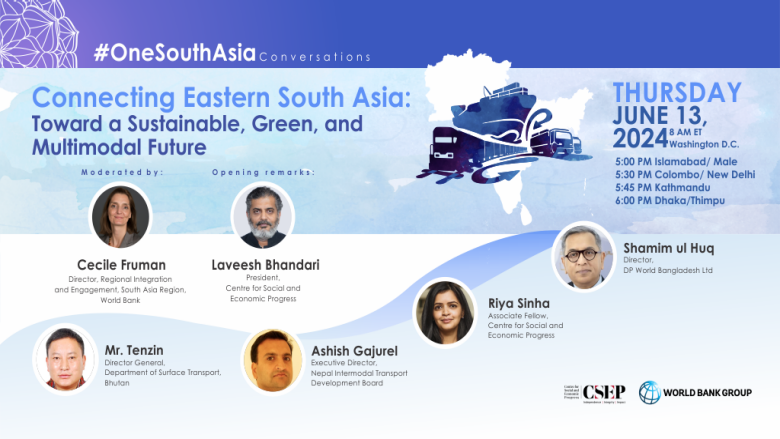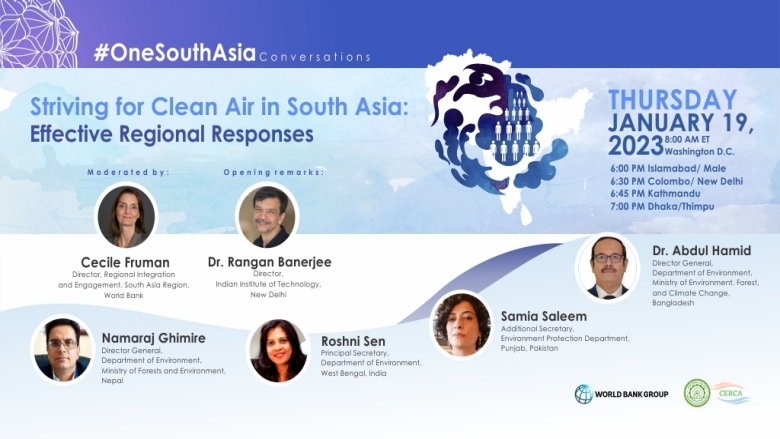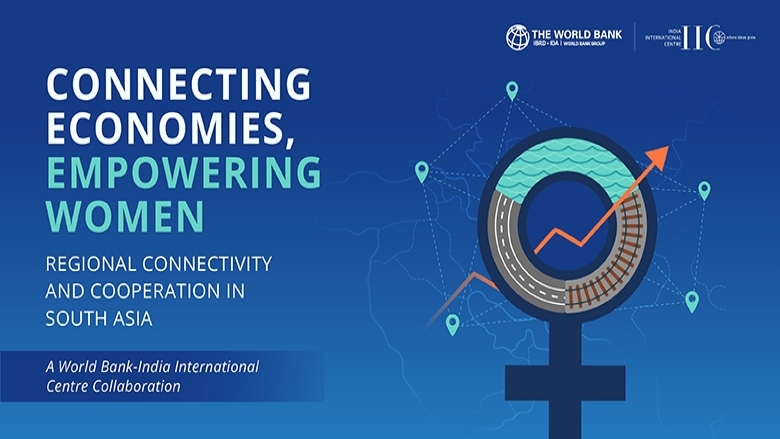Why #OneSouthAsia?
#OneSouthAsia Conversations

End Pollution: AI, Innovation, and Ideas in South Asia
South Asia is home to 9 out of 10 most polluted cities globally. The region also faces another critical challenge of plastic pollution, with South Asia being the second largest contributor of solid waste globally —with over 334 million tons generated annually. The region’s transboundary rivers carry much of this solid and #plasticwaste from land to oceans and across borders. Our 21st OneSouthAsia conversation focused on the use of social and technological innovation, artificial intelligence, and new ideas to combat air and plastic pollution in South Asia.

Maritime Ports: Regional Trade and Shared Prosperity in South Asia
The 20th OneSouthAsia Conversation, held in partnership with the Commercial Law Development Program of the U.S. Department of Commerce, focused on the role of maritime ports in increasing regional and global trade and supporting shared prosperity in South Asia.
Toward Sustainable, Green, and Multimodal Future
Our 19th OneSouthAsia Conversation will explore opportunities and challenges of strengthening multimodal connectivity in Eastern South Asia—what will it take to build sustainable and seamless connectivity in the region? Multimodal connectivity is not only faster, cheaper, but also has significantly high carbon benefits. For instance, rail transport emits roughly 20 % of the greenhouse gas emissions as compared to trucks and is almost four times more cost effective for long distance haulage. Similarly, a bulk IWT carrier emits 10% of GHG emissions as compared to a truck.
Good Neighbors: Connecting People and Ideas across Borders
Our 18th #OneSouthAsia Conversation was held in partnership with the India International Center, New Delhi, where we brought together prominent South Asian voices to discuss ways to strengthen people-to-people connectivity and ideas across borders. This Conversation builds on our report, Good Neighbours: Advancing Regional Integration, Cooperation and Engagement in South Asia, which showcases successful cross-border stories that promote understanding, trust, and people-to-people contacts. This is the recorded version of the panel discussion.
Harnessing Transboundary Rivers
South Asia is home to 1/4th of the global population, but only accounts for 4% of the world's annual renewable water resources. It is estimated that by 2050 between 1.5 to 1.7 billion people in the region will be exposed to water scarcity. With these projections and challenges, regional cooperation and collaborative transboundary water management is critical. Our Conversation brought together stakeholders from the region to discuss what will it take to build a stronger regional transboundary water collaboration—what are the benefits, opportunities, and challenges to it?
Advancing Higher Education Cooperation in South Asia
Our 16th #OneSouthAsia Conversation focused on exploring opportunities for collaboration in the higher education sector in South Asia. The event brought together policymakers and practitioners from the region to discuss the challenges and benefits of working together in areas including research, innovation, knowledge exchange, peer review and quality assurance. The Conversation built on our latest report Regional Integration for Higher Education Development: Options for the South Asia Region.
Women in Regional Trade in South Asia
Our 15th #OneSouthAsia Conversation explores ways to bridge gender gaps in intraregional trade and entrepreneurship in South Asia and lays out pathways that will further integrate women in economic growth across the region. It focuses on opportunities and impediments to more inclusive trade and businesses, with a spotlight on cross-border approaches and how women’s participation can be strengthened.
Striving for Clean Air in South Asia
The 14th OneSouthAsia Conversation focused on collaborative action needed across countries in South Asia, particularly of the Indo Gangetic Plain, to tackle air pollution. The conversation brought together a panel of representatives from governments of the Indo-Gangetic Plain and was held in partnership with the Centre of Excellence for Research in Climate Change and Air Pollution, Indian Institute of Technology, New Delhi.
Resilient Together: Managing Disaster and Climate Risks in South Asia
The 13th OneSouthAsia Conversation focused on collective action and collaboration needed across countries in South Asia to adapt and build resilience to climate-related disasters and challenges.
Deepening Linkages between South Asia and Southeast Asia
The 12th #OneSouthAsia Conversation, explored the potentials and constraints of greater economic collaboration between South Asia and Southeast Asia. It built on the World Bank's latest analysis on Deepening Linkages between South Asia and Southeast Asia, which explores new approaches to revitalize trade and economic links between the two regions, focusing on areas like digital, environmental goods, and services.
Innovate and Mitigate: Emerging Solutions for Climate Resilience in South ...
South Asia is among the most vulnerable regions to climate risks. More than half of all South Asians, or 750 million people, were affected by one or more climate-related disasters in the last two decades. The 11th OneSouthAsia Conversation focused on the ways South Asian countries can leverage innovation and technologies to build climate resilience and collaborative cross-border solutions.

Connecting across Borders: South Asia's Digital Opportunity
South Asian countries can tap the immense digital potential with better infrastructure, improved digital skills, enhanced digital inclusion and protection. Also, more can be done to unlock opportunities by improving access to capacity and connecting currently disadvantaged landlocked countries; boosting cross-border digital payments cross border data flows.

Regional Power Trade: Toward a Green, Clean, and Energy-secure South Asia
The nascent power trade among Bangladesh, Bhutan, India, and Nepal is poised to expand as nations harmonize energy policies, hydropower and transmission plans, technical specifications, and commercial requirements. A #OneSouthAsia Conversation explored the benefits and challenges ahead.

Path to Recovery: Embracing Intraregional Investments in South Asia
Governments can help the private sector create jobs by easing restrictions on investments so companies can open trade offices, build manufacturing plants, and license services in a neighboring country. Also needed are transboundary industry meetings and women’s networks -- low-cost actions with high impact.

Harnessing Technology to Build Human Capital in South Asia
Rapid advances in digital platforms, AI, Big Data, and other technology offer ways to improve social services and job opportunities throughout South Asia. A key step is for the region to work together on policies that narrow the digital divide and set data governance protections for all.

Breathing Uneasy: Regional Response to Air Pollution in South Asia
About 95 percent of South Asians are breathing air that fails international safety standards. Dirty air from brick kilns, wood stoves, vehicles, and industrial plants blows across national boundaries and requires a collaborative response.

Turning the Tide on Marine Plastics in South Asia
Plastic pollution is choking the major rivers and seas of South Asia, affecting the health and livelihoods of 2 billion people. The World Bank is working with all eight nations to build a circular economy for plastic and find innovative substitutes for its use.

Connecting to Thrive: Transport Integration in South Asia
Seamless Bangladesh-India transport links can boost national incomes, speed up shipments, and cut costs, benefitting millions. Steps needed include simplifying border procedures, adding multimodal options, and fully adopting the 2015 Motor Vehicles Agreement.

Pivoting in a Pandemic: Women Entrepreneurs Tap Regional Opportunities
South Asia has the lowest rate of women entrepreneurs among global regions. To rebuild after COVID-19, South Asia needs women-led businesses to drive innovative services and products, create jobs, and close gender gaps.

Feeding South Asia in Times of Crisis
The pandemic pushed food prices up 10% in South Asia. Regional cooperation can help stabilize food supplies by easing trade barriers and managing climate change impacts on crop production.











